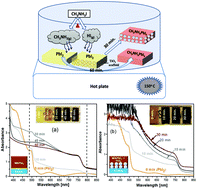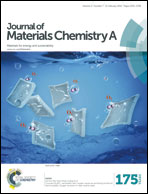Vapor phase conversion of PbI2 to CH3NH3PbI3: spectroscopic evidence for formation of an intermediate phase†
Abstract
The formation of CH3NH3PbI3 (MAPbI3) from its precursors is probably the most significant step in the control of the quality of this semiconductor perovskite material, which is highly promising for photovoltaic applications. Here we investigated the transformation of spin coated PbI2 films to MAPbI3 using a reaction with MAI in vapor phase, referred to as vapor assisted solution process (VASP). The presence of a mesoporous TiO2 scaffold on the substrate was found to speed up reaction and led to complete conversion of PbI2, while reaction on glass substrates was slower, with some PbI2 remaining even after prolonged reaction time. Based on data from UV-visible spectroscopy, Raman spectroscopy, X-ray diffraction and X-ray photoelectron spectroscopy, the formation of an X-ray amorphous intermediate phase is proposed, which is identified by an increasing absorption from 650 to 500 nm in the absorption spectrum. This feature disappears upon long reaction times for films on planar substrates, but persists for films on mesoporous TiO2. Poor solar cell performance of planar VASP prepared devices was ascribed to PbI2 remaining in the film, forming a barrier between the perovskite layer and the compact TiO2/FTO contact. Good performance, with efficiencies up to 13.3%, was obtained for VASP prepared devices on mesoporous TiO2.



 Please wait while we load your content...
Please wait while we load your content...